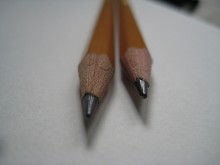
In 1795, Nicolas-Jacques Conté (French painter, army officer and balloonist) created the modern-day pencil.
Why Was the Pencil Made?
Due to the economic blockade imposed during the French revolution, France was unable to import graphite sticks from Great Britain or graphite pencils from Germany. French politician Lazare Carnot asked Conté to design a pencil that could be produced in France without the need for foreign imports.
Nicolas-Jacques Conté and Joseph Hardtmuth
Although Conté received the patent for his invention in 1795, Austrian Joseph Hardtmuth's pencil factory was using the same method to make such pencils in 1792.
Conté made pencils by combining clay and powdered graphite, a mixture which he would then bake in a kiln and insert between two wooden half-cylinders. These would then be sealed together to form the casing. For harder or darker pencils, more graphite and less clay would be used in the mix.
The main differences between these pencils and those that had been used previously are the materials used for the 'lead' and the easy and cheap method of manufacturing.